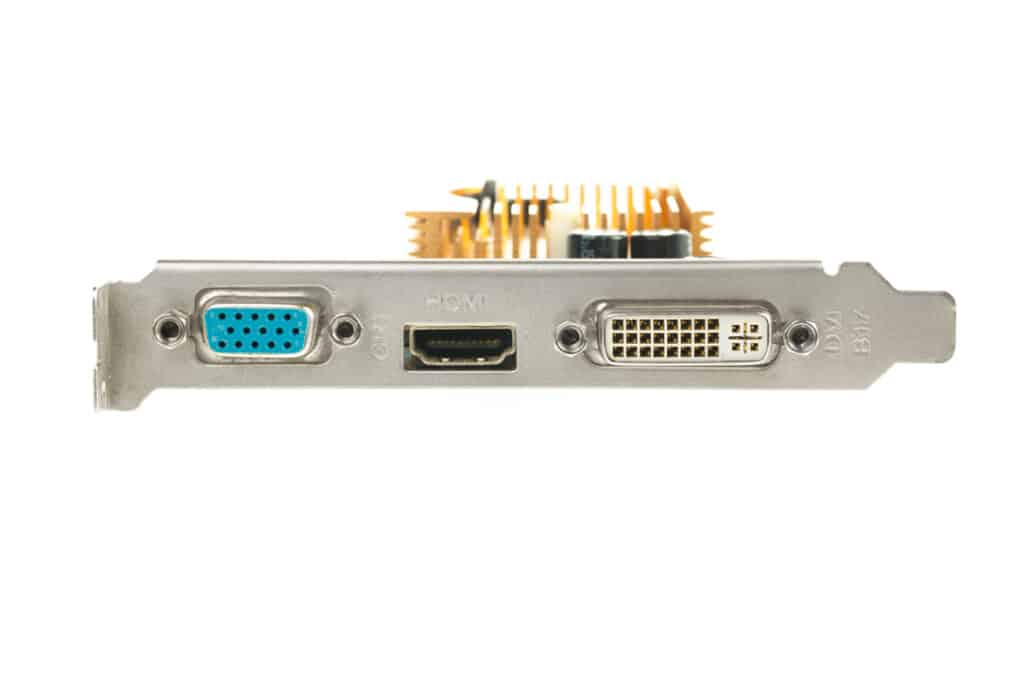When you want to boost the graphics on your personal computer, it’s time to consider a more powerful graphics processing unit (GPU). This means purchasing a new graphics card for your PC. This can be an expensive purchase, so here’s some advice on how to choose a graphics card.
How Do You Use Your Computer?
The first consideration for how to decide what GPU to get is how you use your computer. The more graphics-intensive your computing activities, the more likely you’ll want a higher-end graphics card.

Gaming
The most graphics-intensive activity you can do on your computer plays the latest, greatest PC games. If you’re a serious gamer, you’ll need a more powerful GPU to smoothly reproduce your games’ realistic graphics.
Today’s sophisticated PC games require a high-performance GPU that can render realistic and fast moving on-screen graphics. In fact, many serious gamers consider the GPU as the most important component in their gaming PCs. A high-powered graphics card makes gaming a joy; an underpowered graphics card can result in lagging performance and disappointing graphics.
Know, however, that not all games have the same graphics requirements. Some less realistic games don’t need the same powerful GPUs required by today’s state-of-the-art games. Check your most played games’ specs and make sure the GPU you choose matches or exceeds these requirements.
Video Editing and CAD
Video editing and computer-aided design (CAD) are both graphics-intensive applications that require powerful graphics cards. This is especially true when editing large video projects at 4K resolution or rendering 3D designs in AutoCAD. A “workstation” GPU optimized for these creative applications can speed up processing and rendering and make for a more efficient workflow.
Normal Use
If you’re not a serious gamer or professional video editor/designer, you probably don’t need a high-powered graphics card. Normal office work, web browsing, and the like are not very demanding in terms of graphics. Even watching videos doesn’t use a lot of graphics processing power. So if your computer usage is more mundane, you’re probably fine with the graphics built into your system’s motherboard. You won’t gain much if anything by upgrading to a higher-end graphics card.
How Much Money Can You Spend?
For many users, price is a big factor in choosing a graphics card. Low-end cards can be found for less than $100, but they probably won’t be adequate for today’s cutting-edge PC games. The most expensive cads run well over $1,000 (some as high as $2,500), but you may not need that amount of graphic processing power. Set your budget and then choose the most appropriate card in that price range.
AMD or Nvidia?
Two companies make all the GPUs used in high-end graphics cards today. AMD and Nvidia are the names to choose from, whether you’re looking at their own branded graphics cards or third-party cards that use their GPUs.
Which company has the best GPUs? They’re both good but tend to specialize at different levels. AMD is strong with budget and mid-range GPUs. Nvidia is more dominant at the higher end of the market.
Also important is which graphics technology your monitor supports, AMD’s FreeSync or Nvidia’s G-Sync. Both technologies synchronize the refresh rate between the monitor and the graphics card for better performance. (If your monitor doesn’t support either technology, then you can go with either brand.)
What’s Your Monitor Resolution and Refresh Rate?

You’ll want to make sure that the graphics card you choose matches the resolution of your video monitor. This is especially important if your monitor supports the 4K resolution and triple-digit refresh rates used in today’s most demanding PC games. However, if your monitor is only capable of 1080p resolution with a 60Hz refresh rate, you don’t need a higher-powered GPU.
Do You Have Room in Your System Case?
This may seem like a blatantly obvious consideration, but you have to make sure that the graphics card you choose actually fits in your computer’s system case. While graphics cards come in all shapes and sizes, most cards for gamers are dual-slot and full-height – although some high-powered cards occupy three slots in your PC!
The space issue goes beyond how many slots you need. If a graphics card has a big heatsink and fan, it can block the space above adjacent slots. Consider how much available space you need and how much you have.
Is Your Power Supply Big Enough?
It takes a lot of juice to power today’s high-performance GPUs. You’ll want to make sure your PC’s power supply is big enough to handle the needs of the graphics card you choose.
In this matter, look for the card’s Thermal Design Power (TDP) spec. TDP measures how well the card dissipates heat and provides an estimate of how many watts of power you need. For example, a card with a 200-watt TDP will pull 200 watts from your power supply – in addition to whatever else in your unit that’s drawing power. If you choose a graphics card with a high TDP rating, you may need to upgrade your PC’s power supply to compensate.
What Connections Do You Need?
Make sure your graphics card has the type of output that matches your monitor’s input. Most modern monitors have HDMI inputs, as do most modern graphics cards. Older monitors may have DVI or DisplayPort inputs, which may require an adapter if your graphic card only has an HDMI output. If you’re running output to multiple monitors, make sure your card has multiple ports of the proper types.
How Much Graphics Memory Do You Need?

All graphics cards have some amount of random access memory (RAM) onboard. For general gaming purposes, look for a card with 3G-4G graphics RAM. For higher-resolution games, you may need 8G or more RAM.
How Much Speed Do You Need?

A GPU is a microprocessor, just like your computer’s central processing unit (CPU), and its speed is measured in a similar fashion. The faster the GPU, the more smoothly it will render fast-moving on-screen action. Some GPUs are overclocked to achieve higher speeds, which can both improve performance and increase internal heat.
Some GPUs utilize multiple cores, which effectively makes a single GPU act like multiple GPUs. In general, a GPU with multiple cores will increase graphics performance.
Do You Need Ray Tracing?
Ray tracing is the newest technology for reproducing realistic on-screen graphics. This technology creates lighting effects that simulate how light works in the real world. It works by “tracing” the path that light would follow if it were to travel from your eyes (in the real world) through the virtual scene on the computer screen. With ray tracing, light can reflect off objects, be blocked and create shadows, or even be refracted as it passes through transparent or translucent objects.
Some newer games are beginning to incorporate ray tracing technology, enhancing the reality of gameplay. To play these games, you’ll need a GPU that can handle the demands of ray tracing, which means a more expensive graphics card. While there aren’t a lot of games that currently incorporate ray tracing, it is the future of PC gaming. If you want your system to be future proof in this regard, invest in a GPU that supports ray tracing technology.
Do You Need It to Support Virtual Reality?
Finally, if you play virtual reality (VR) games or use VR apps, you’ll want a graphics card that supports VR technology. The two leading VR platforms for the PC are HTC Vive and Oculus Rift, and you’ll need at least a mid-range graphics card to work with either. Higher-end cards will produce optimal performance with VR games and apps.
Driver Support Can Keep Your Graphics Drivers Up to Date
When you invest in an expensive graphics card, you want to maintain optimal performance by keeping your graphics drivers up to date. You can use Driver Support to keep all the drivers on your computer, including your graphics drivers, current and in prime operating condition.
Driver Support scours your system for all active device types supported. When you fully register the service, it automatically updates any drivers that are missing or out of date. Contact us today for further assistance.


